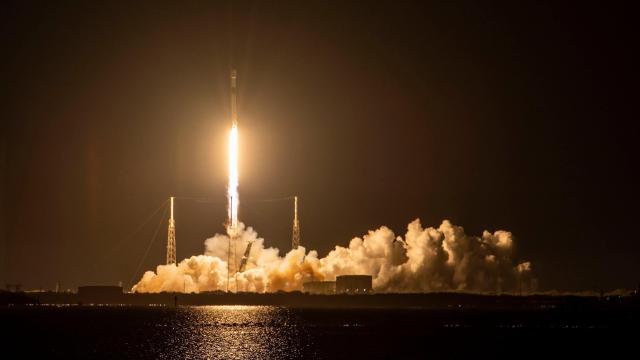With only a small handful of days left in the year, SpaceX achieved a major milestone by pulling off its 60th orbital launch of the year — a goal that CEO Elon Musk had been targeting for the space company.
A Falcon 9 rocket launched on Wednesday, lifting off at 8:34 pm AEDT from the Cape Canaveral Space Force Station in Florida. The rocket carried 54 Starlink satellites, which may have been the first batch of SpaceX’s next generation satellites under a newly acquired licence.
This might actually be the first time SpaceX has met one of its publicly announced goals, or at least a goal having to do with its expected frequency of rocket launches. As spaceflight reporter Eric Ralph of Teslarati points out, it’s the “first time the company has fully hit a public cadence target set by one of its executives.” Earlier in the year, SpaceX CEO Elon Musk announced that his company was aiming for 60 orbital launches in 2022. We’ve learned not to take his public decrees too seriously as the billionaire often sets unrealistic expectations for his private space venture, such as the timing of the first Starship rocket launch, which hasn’t yet happened.
That it took SpaceX a standing fleet of ~20 boosters to achieve this amazing flight rate also underscores how unrealistic the space shuttle’s original goals were with a fleet size of only 4. https://t.co/lBdGV8fbTn
— Max Fagin 🚀🔴🌐☄🌘 (@MaxFagin) December 28, 2022
Thanks mostly to its workhorse rocket, however, SpaceX did live up to Musk’s promise of delivering 60 orbital launches before the year was over. Indeed, all but one of these launches was done with Falcon 9s, the lone mission being the launch of the rarely used Falcon Heavy. As for Starship, it won’t fly this month as Musk had claimed, though a launch in 2023 does seems likely.
The latest launch put the total number of Starlink satellites in orbit at 3,374, of which 3,335 are operational, according to stats collected by astrophysicist Jonathan McDowell.
Wednesday’s launch carried a special payload, or at least we think it did. We’re not entirely sure owing to SpaceX’s hazy description of the mission. SpaceX’s Starlink Group 5-1 mission “marked the first of Starlink’s upgraded network,” the company wrote on its website. “Under our new licence, we are now able to deploy satellites to new orbits that will add even more capacity to the network,” SpaceX added. “Ultimately, this enables us to add more customers and provide faster service — particularly in areas that are currently over-subscribed.” The “group 5-1″ designation suggests this is the fifth shell, or group, of Starlink satellites.
Now @SpaceX are saying the new FCC licence lets them deploy Starlinks to the new shell – but my reading of the FCC statement suggests they are meant to deploy Gen2 sats *only* to this new shell, and it is not clear yet whether the ones on this launch are Gen1 or Gen2
— Jonathan McDowell (@planet4589) December 28, 2022
Earlier this month, SpaceX filed a request with the Federal Communications Commission to grant it a 60-day special temporary authority to connect Starlink terminals already in use to the next generation satellites it’s aiming to launch. In the regulatory filing, SpaceX stated its desire to start launching its Gen2 Starlinks in December 2022. In early December, the FCC approved the launch of 7,500 second-generation Starlink satellites to low Earth orbit, while deferring its decision on the remaining 22,488 satellites that SpaceX is hoping to launch.
The next generation of Starlink satellite, known as Gen2, will be larger and more powerful than its predecessor, allowing the company to meet the increasing demand for its space-based internet service. SpaceX is planning to use Starship rockets to deliver the large Gen2s to orbit, but, as the rocket is not yet ready, it said Falcon 9s would deliver a compact version of the Gen2s. Again, it’s not clear which version reached space earlier today, but what is clear is that the units conformed to the Gen1 form factor.
There is an ‘F9-1’ variant described by SpaceX which has indeed Gen2 equipment on Gen1 form factor sats. The implication from the SpaceX filing was a single F9-1 satellite, but maybe they meant a *type* of satellite. SpaceX are consistently vague in everything they say.
— Jonathan McDowell (@planet4589) December 28, 2022
Regardless, SpaceX has had quite the year and the company’s founder is aiming even higher. In 2021, SpaceX launched its Falcon 9 rocket a relatively measly 31 times and one year later it nearly doubled that total. Musk previously stated that he’s aiming for 100 launches in 2023. We’ll see how well the next year goes for the private company, which is already miles ahead of its competition in the private space industry.
More: The Potential for Larger — and Brighter — Starlink Satellites Has Astronomers Worried
